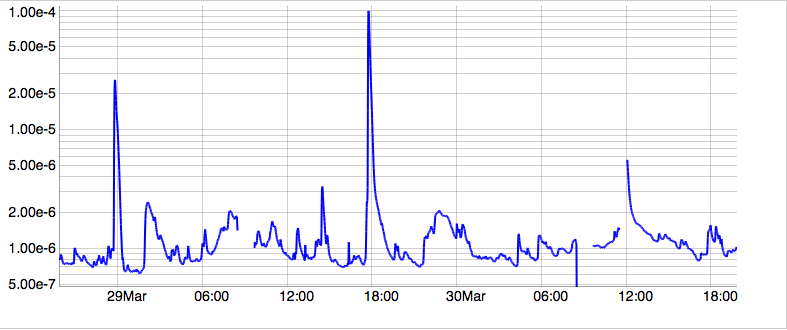Solar Flare Photos of March 29, 2014: See the Best-Observed Sun Storm Ever (Gallery)
IRIS Image of March 29 Solar Flare

NASA's Interface Region Imaging Spectrograph, or IRIS, captured this image of the X-class flare. [Read the Full Story and Watch the Video Here]
March 29 Solar Flare in 1400 Angstrom

This image shows light at a wavelength of 1400 Angstrom, which highlights material some 650 miles above the sun's surface. The vertical line in the middle shows the slit for IRIS's spectrograph, which can separate light into its many wavelengths to provide even more information about the temperature and velocity of material during a flare. [Read the Full Story and Watch the Video Here]
March 29 Solar Flare in 304 Angstrom

The March 29, 2014, X-class flare appears as a bright light on the upper right in this image from SDO, showing light in the 304 Angstrom wavelength. [Read the Full Story and Watch the Video Here]
March 29 Solar Flare by RHESSI

NASA's Reuven Ramaty High Energy Solar Spectroscopic Imager, or RHESSI, observes both the intense particle acceleration caused by the flare and the hottest temperature material. [Read the Full Story and Watch the Video Here]
March 29 Solar Flare in 171 Angstrom

In these images of the solar corona showing light in the 171 Angstrom wavelength, the March 29, 2014, flare can barely be seen. However light in this wavelength does clearly show the beautiful loops of charged particles – tracing out the sun's magnetic field lines -- that can clearly be seen rising up on the sun's horizon. [Read the Full Story and Watch the Video Here]
March 29 Solar Flare in 131 Angstrom

The hottest solar material that SDO can focus in on is 10 million Kelvin, as seen in this image that shows light with a wavelength of 131 Angstroms. At these temperatures, the blazingly hot solar flare can easily be seen in the upper right of the sun. [Read the Full Story and Watch the Video Here]
March 29 X-class Flare by GOES

This data shoes how the National Oceanic and Atmospheric Administration's Geostationary Operational Environmental Satellite, or GOES, recorded the X-class flare. Note the high spike just before 18:00 – the Universal Time equivalent of 2:00 p.m. EDT -- on March 29. [Read the Full Story and Watch the Video Here]
Get the Space.com Newsletter
Breaking space news, the latest updates on rocket launches, skywatching events and more!
Join our Space Forums to keep talking space on the latest missions, night sky and more! And if you have a news tip, correction or comment, let us know at: community@space.com.

Space.com is the premier source of space exploration, innovation and astronomy news, chronicling (and celebrating) humanity's ongoing expansion across the final frontier. Originally founded in 1999, Space.com is, and always has been, the passion of writers and editors who are space fans and also trained journalists. Our current news team consists of Editor-in-Chief Tariq Malik; Editor Hanneke Weitering, Senior Space Writer Mike Wall; Senior Writer Meghan Bartels; Senior Writer Chelsea Gohd, Senior Writer Tereza Pultarova and Staff Writer Alexander Cox, focusing on e-commerce. Senior Producer Steve Spaleta oversees our space videos, with Diana Whitcroft as our Social Media Editor.









